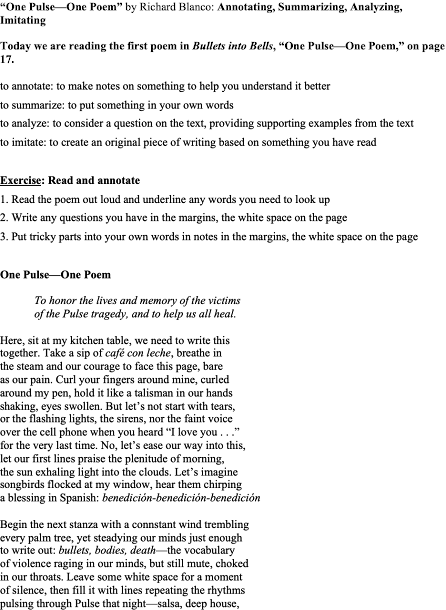Week 21: College Reading and Writing: Billy Collins and Nicole Hockley
Prof. Kate Glavin is taking over for the summer--this is one of her handouts.
Week
21: College Reading and Writing: Billy Collins and Nicole Hockley
Billy
Collins and Nicole Hockley: Annotating, Summarizing, Analyzing, Imitating
to
annotate: to make notes on something to help you understand it better
to
summarize: to put something in your own words
to
analyze: to consider a question on the text, providing supporting examples from
the text
to
imitate: to create an original piece of writing based on something you have
read
We are
doing the ninth poem and response in the book today, starting on page 28.
Exercise: Read and annotate
1. Read
the poem and response out loud and underline any words you need to look up
2. Write
any questions you have in the margins or in your notebook
3. Put
tricky parts into your own words in notes in the margins or in your notebook
Exercise:
Questions for Comprehension of the poem
1. How does
nature (i.e., winter, birds) in the poem reflect or contribute to the mood or
meaning?
2. What does
Collins mean when he writes “History will never find a way to end”
regarding the boy shooting at the statues?
3. What is the significance of paper as “pieces of glass” in which
the speaker can see “swarms of dark birds circling in the sky”?
Exercise:
Summarize the poem
Write a paragraph summarizing the poem with quotations, in-text
citation, and a Work Cited Page.
example too-short summary, incorporating quotation and in-text
citation:
Billy Collins’ poem “Boy Shooting at Statue” begins with the
speaker describing walking through an almost empty park where he sees a boy
“running alone/in circles around the base of a bronze statue.” The speaker just
watches as the boy runs in circles, using “his hand for a gun,” lifting
“his finger to the statue,” pretending to shoot (28-29).
Work
Cited Page
Collins,
Billy. “Boy Shooting at a Statue.” Bullets Into Bells: Poets and Citizens
Respond to Gun Violence. Ed. Brian Clements et al. Beacon Press, 2017.
Exercise:
Questions for Comprehension of the response
1. What does Hockley believe sustains the conflict around the topic of
gun violence?
2. What does Hockley believe is the universal goal of this debate?
3. Who does Hockley believe is responsible for the changes needed to
prevent gun violence?
Exercise:
Summarize the response
Write a paragraph summarizing the response with quotations,
in-text citation, and a Work Cited Page.
Exercise: Analysis
Question
for analysis: Collins and Hockley seem to be in agreement that that the history
of gun violence in America keeps repeating itself. Collins’ poem is set
in winter, and Hockley refers to the non-action around this issue as a “long
winter” (30). If the winter represents the political climate (or mood) around
gun violence, who might the boy represent in this “polarized and divisive”
topic (30)?
Exercise: Imitation
Write
your own poem in tercets (stanzas of three lines each) where you use
juxtaposition to emphasize the theme of the poem. For instance, Collin uses a
seemingly innocent scene of a boy playing in a park to illustrate how common
gun violence is in our culture and how desensitized we’ve become to it. Write a
poem where you place two very different objects or people or places together to
emphasize and draw attention to the point you want to make.
For
homework, revise these in a blue book or on loose paper; do not turn in your
notebook or rip out pages to turn in.
Homework:
1.
Summary of Poem
2.
Summary of Response
3.
Analysis of Poem and
Response
4.
Imitation of Poem
About
this class:
In this
class, you are welcome to submit homework for a grade. If it’s not strong
enough to earn an A, I’ll give you some comments to help you revise it, and let
you do it over again. You have as many chances as you want to complete and
perfect the work in this class, and you are welcome to do more than one week’s
worksheet for homework at a time; ask me for sheets you’ve missed.
Students who complete 15 weeks of graded assignments and a longer paper can
qualify for college credit. When you get close to completing 15 weeks, I’ll
help you get started on your longer paper.


Comments
Post a Comment